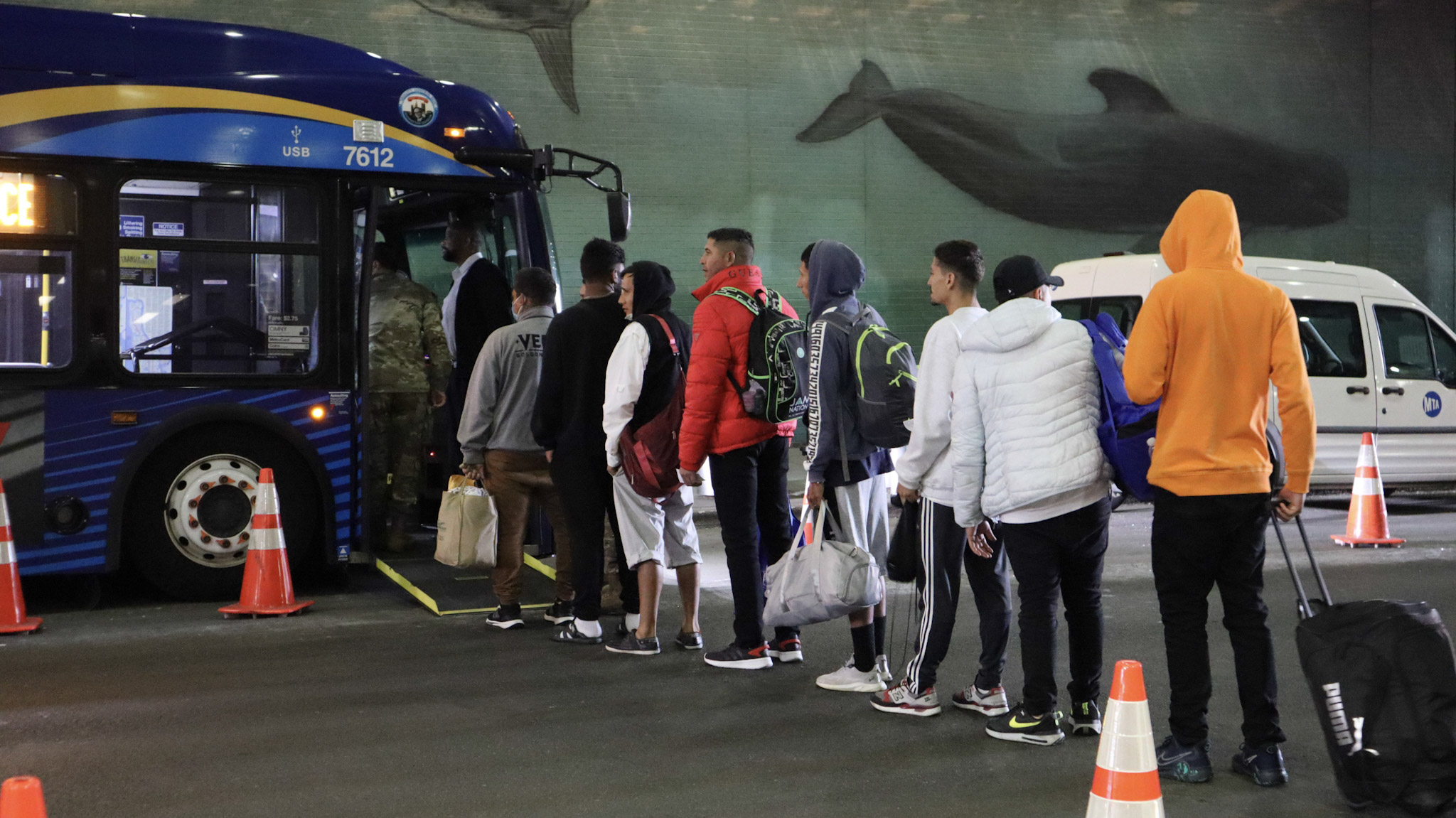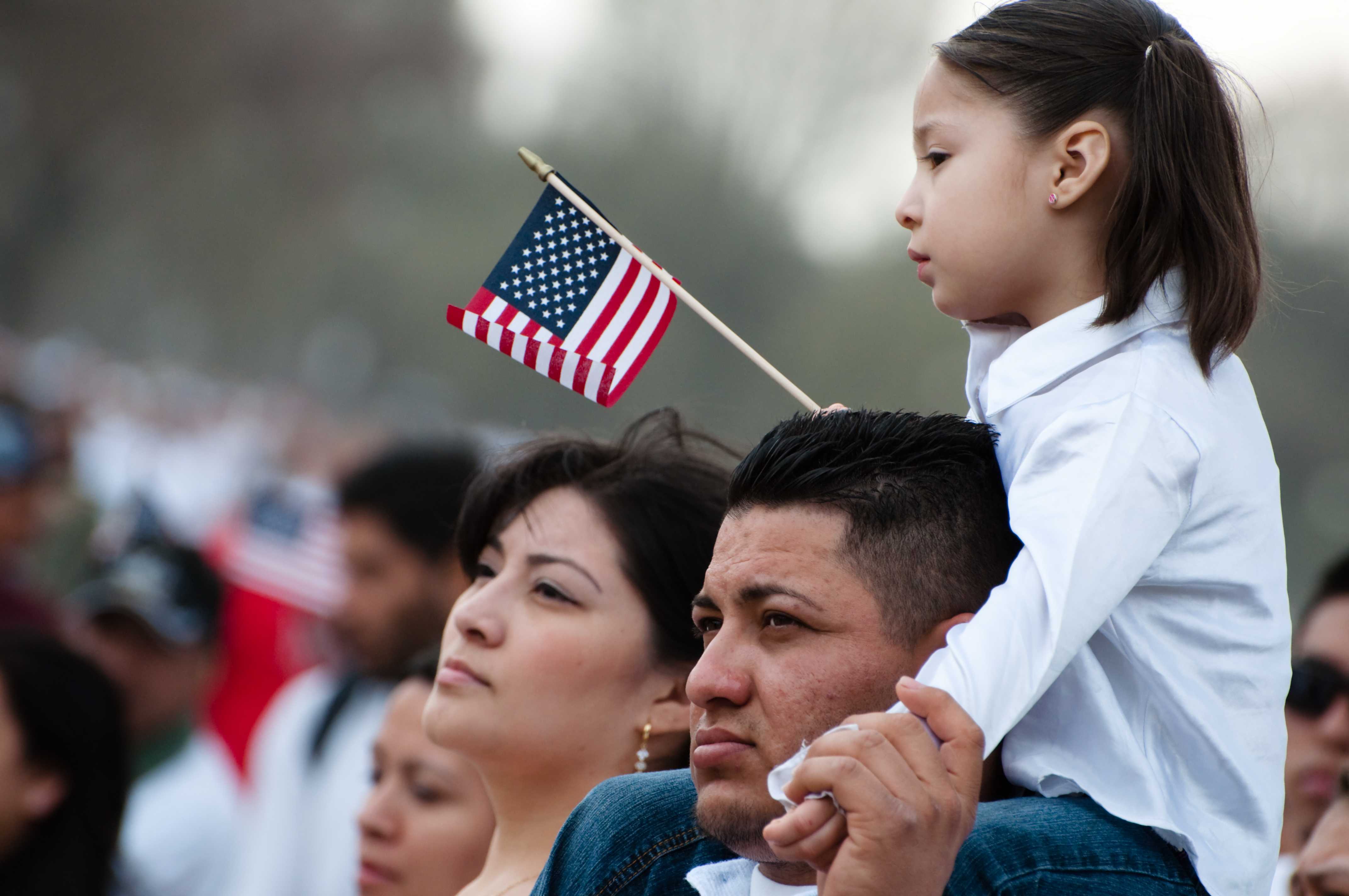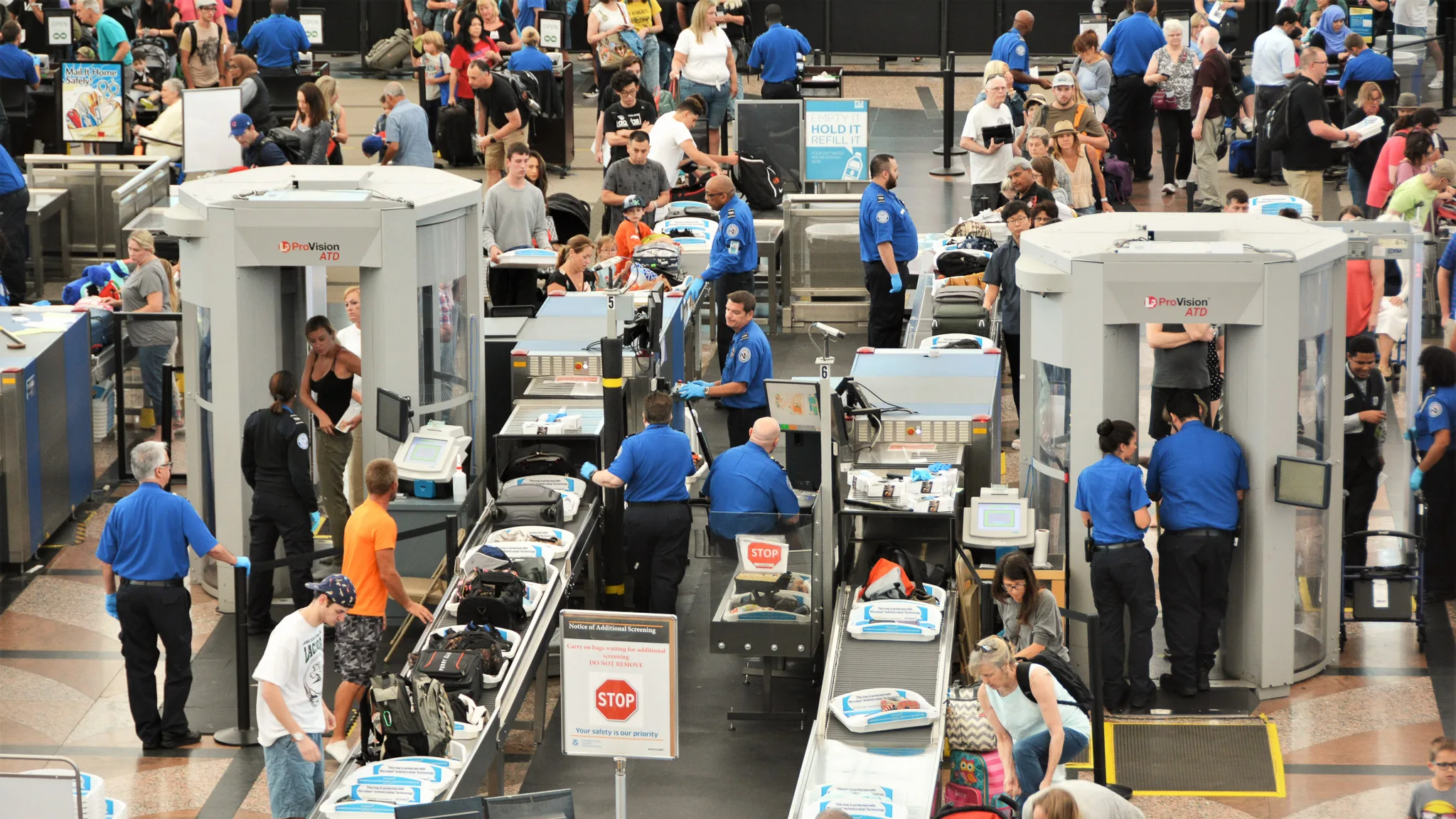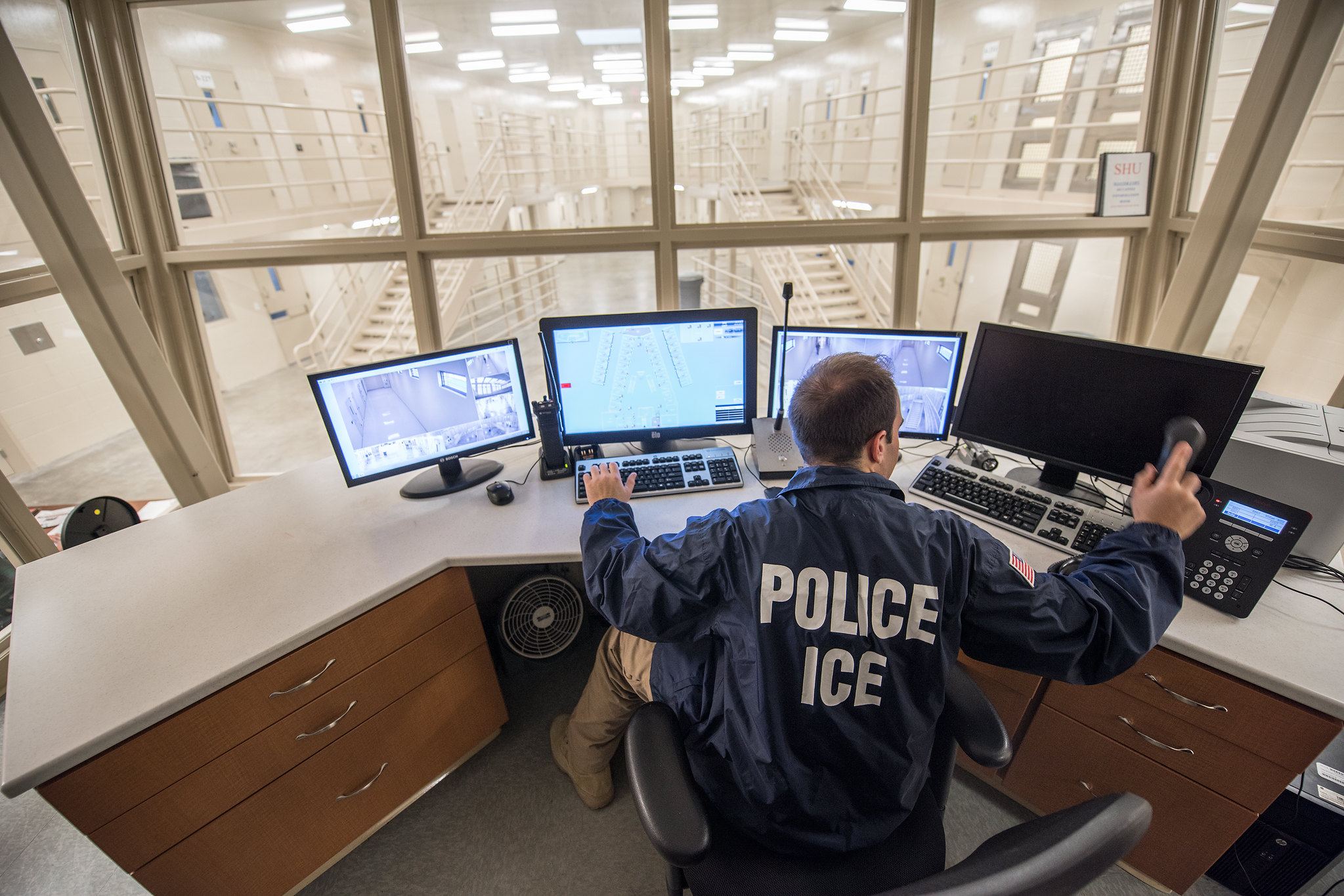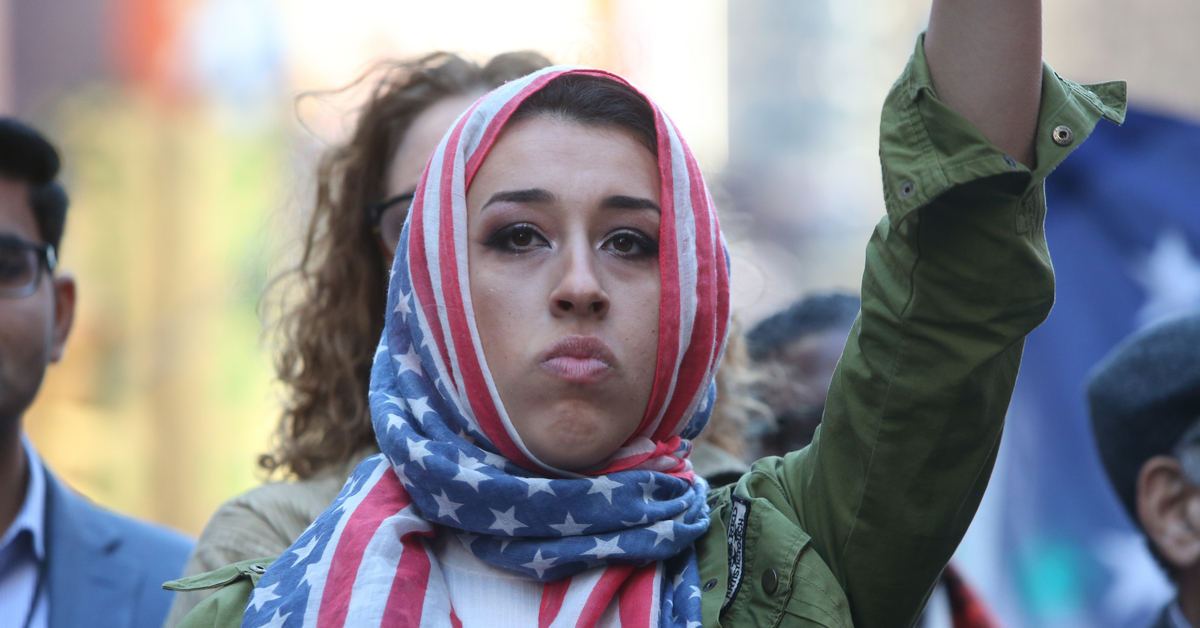The men and women huddled behind metal barriers, some under blankets. It was just after 6 a.m. on Wednesday morning and they had recently stepped off buses, clutching pillows and their belongings. Many traveled 30 hours from Texas just to get here. Children clung to the hands and legs of their parents, as volunteers and National Guard members who had been up since the earlier hours of the morning handed out fruit, bagels and coffee. Others embraced with family members who had come to meet them, afterwards, likely making their way together to hotel shelters across the city.
Also Read: Mayor Adams Demands Biden Expand Work Permits, Protections for Asylum Seekers
This has become a common scene at the New York City Port Authority bus station over the past year, as more than 61,000 asylum seekers have made their way through the City’s care since last spring.
The Trump-era policy Title 42, which allowed immigration officials to expel migrants without letting them seek asylum, is scheduled to end on Thursday. For months, advocates and city officials envisioned having to rapidly ramp up the services they were already providing to the lines of people coming through bus station doors and landing on plane runways, as the end of the policy could prompt more people to make their way to New York. However, the Biden administration announced strict asylum regulations to stem the number of people coming into the U.S., which will go into effect as soon as Title 42 expires.
City officials and advocates worry that without an improved coordination between federal and local governments, the end of the program could push an already shaky housing infrastructure and shelter system to the brink.
On Wednesday, New York City Mayor Eric Adams signed an emergency executive order which temporarily suspended provisions of the City’s right to shelter law. The executive order, first reported by Gothamist, included directives to suspend the prohibition of congregate settings for women and children, and to suspend a rule related to the evening deadline to obtain shelter for families with children.
“We have have reached our limit,” Fabien Levy, a spokesman for Mayor Adams, said in a statement. “The city has temporarily suspended the policy surrounding timing for placements in shelters. This is not a decision taken lightly and we will make every effort to get asylum seekers into shelter as quickly as possible as we have done since day one.”
Now that the Biden administration has added further restrictive measures to asylum law, the future is unclear. However, city officials have pleaded with the federal government to allocate additional funds to aid New York City — on top of the $800 million that the federal government has allocated for the entire country — and some immigrant advocates say they are taking on a tremendous bulk of the work assisting asylum seekers in the absence of sufficient City backing.
Border controls intensify
On Wednesday, the Biden administration finalized plans to further roll back asylum protections by instituting a rule that migrants must first seek asylum or other protections in a country they travel through, while making their way to the southern border. If they fail to do so and cross the border without authorization into the U.S., they will likely be presumed ineligible for asylum — with some exceptions — according to the new regulations.
“Let me be clear: The lifting of the Title 42 public health order does not mean our border is open,” Sec. of Homeland Security Alejandro Mayorkas said at a press conference on Wednesday. “We are making it very clear that our border is not open, that crossing irregularly is against the law, and that those who are not eligible for relief will be quickly returned.”
Immigration authorities have encountered upwards of 10,000 people crossing the U.S.-Mexico border some days this week, various news organizations have reported.
It’s unclear just yet how the rule could affect the number of asylum seekers arriving in New York. But local officials Wednesday were still concerned about how to ensure the people arriving in the City in the coming days and weeks receive proper attention and care.
The City looks for shelter space
More than 61,000 migrants have passed through the City’s care since last spring. More than half — about 37,500 — are still in the City’s care as of last week. In the past week, advocates say several buses with migrants have arrived from Texas as Gov. Greg Abbott restarted his practice of sending migrants out of state on buses to cities including New York, Philadelphia and Chicago.
At a City Council budget meeting on Wednesday, Manuel Castro, the commissioner for the Mayor’s Office of Immigrant Affairs, said that about 600 to 800 migrants have been arriving in New York every day for the past week. Last month, Mayor Adams said at a press conference that 200 asylum seekers were coming to the City daily. There was a recent scramble to find housing for asylum seekers coming to New York on flights, Castro said. “We knew we would see a surge after Title 42 was lifted,” he said. “But it happened sooner.”
New York could see over 1,000 people arriving to the City per day, he added. “On this issue, the White House has failed us,” Castro said at the hearing. “We haven’t seen enough action by the federal government in support of New York City.”
Gov. Kathy Hochul previously pledged $1 billion in the state budget for migrant support services in New York City, and on Tuesday issued an executive order to quickly mobilize these resources for asylum seekers ahead of the end of Title 42. This included help to swiftly buy any necessary supplies. The order will also let the state bring in 500 more National Guard members to provide “logistical and operational support,” raising the total number of National Guard members who have assembled to help to about 1,500.
In the past few weeks, officials have been scavenging across the five boroughs to find options for housing asylum seekers. They’ve asked for space at the famed Flatiron building in Manhattan. They’ve recently opened up a shelter at a former police academy building on East 20th St. They’ve also considered setting up tents in Central Park and Prospect Park.
“Without more support from our federal and state partners, we are concerned the worst may be yet to come,” Levy, the Mayor’s spokesman, said in the statement confirming that parts of the City’s right to shelter law would be suspended.
City officials have also announced plans to house migrants in hotels in Rockland and Orange Counties in the Hudson Valley, but were met with severe pushback from local politicians who have declared states of emergency in response. Rockland County officials said hotels could be fined $2,000 per migrant per day for allowing migrants to stay, and Orange County officials directed all hotels not to take in migrants. On Tuesday night, a Rockland County judge issued a temporary restraining order barring the Armoni Inn and Suites in Orangetown from accepting migrants.
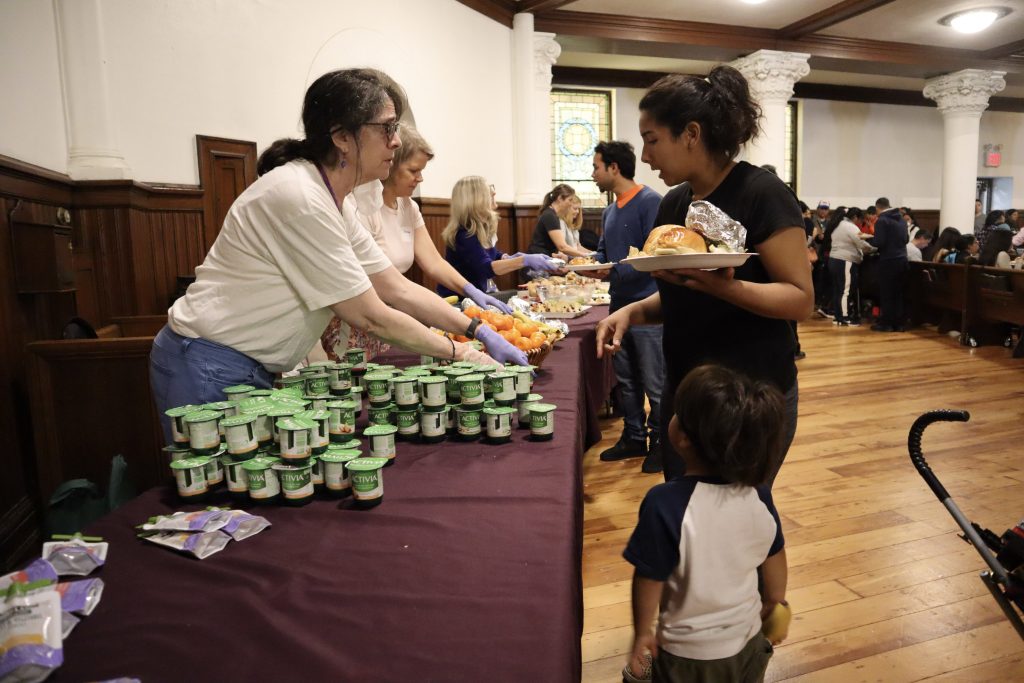
New York City leaders have acknowledged that finding housing for asylum seekers has become increasingly difficult, propelling them to look for options outside of the City. Department of Social Services Commissioner Molly Wasow Park testified at a City Council Budget hearing on Monday that, as of May 4, there were more than 28,300 asylum seekers in the Department of Homeless Services Shelters. She added that the department has opened 126 emergency shelters since the spring of last year.
“We are occupying at this point a large share of hotels in New York City,” Park said.
Also Read: Millions Spent on Hotels for Asylum Seekers in NYC, But Few Lasting Solutions
Joshua Goldfein, a staff attorney at The Legal Aid Society’s Homeless Rights Project, recognized that the City has done “incredible work” with identifying new places to house people — in some cases even just hours before to ensure that people don’t sleep on the street. “On the other hand, I think their concern is that soon they’re going to run out of places that they can use to shelter people that are appropriate,” Goldfein said.
And now, the City is worried that the number of migrants coming to New York every day may increase dramatically, Goldfein said. “Even if they were totally prepared for that, there’s only so many people they can process in a day.”
And without work permits, most asylum seekers haven’t been able to find stable jobs that allow them to pay their rent outside of the shelter system. Many have been stuck in City shelters despite trying to find ways to pay for alternative housing outside of city services, asylum seekers have told Documented.
New Yorkers lend a hand
In interviews with Documented, asylum seekers have said that information about transportation, legal assistance, fresh food, mental health services, clothes donations, and other resources are not always available at the hotel shelters directly. Often, migrants have to leave to find this support.
“The food could be better…we can’t cook,” said Maribel Balseca, a 35-year-old migrant from Ecuador who had come to an Upper West Side Church this week to pick up food, clothes and other assistance. “We have to eat outside of the shelter a lot.”
Balseca arrived in New York about four months ago with her son, after a long journey that included crossing the dangerous Darién Gap. “Because of everything that we went through, I do think sometimes we need someone to guide us,” Balseca said in Spanish.
So a group of New Yorkers has taken it upon themselves to fill these gaps — many without funding from the City, state or the federal government.
At a resource drive held every Monday morning at St. Paul & St. Andrew, a United Methodist Church on the Upper West Side, more than 100 migrants, including Balseca, lined up to receive assistance at the faith center this week. Inside, aid groups and volunteers helped with legal cases, health insurance sign-ups, and change of address forms, among other paperwork. In a back room, migrants combed through reusable grocery bags and racks of clothing for men, women and children of all ages.
In the front pews of the church, migrants waited anxiously as their numbers were called on a microphone to pick up the donated strollers, bikes and scooters they would be able to take back to their shelters that day. One row of tables was lined with breakfast food including bananas, yogurts and bagels, and some children reached their hands up asking volunteers for more.
Rev. James “K” Karpen, said that although the City has been organizing better around providing resources to asylum seekers, official channels still seemed overwhelmed. The Monday morning drives usually serve between 200 to 300 migrants, Karpen said. The church has still even been receiving people who arrived in New York and had been walking on the sidewalk for several nights because they didn’t know where to find shelter. So far, the church has not received any funding from the City and has been relying on donations from individuals who form part of the congregation — who most recently donated about $20,000 in total.
But it’s uncertain how long that model can remain sustainable, especially as more migrants come. “There’s only so many times you can go back to the well,” Karpen said. “I don’t know how we’re going to continue to meet those needs, but we’re going to try to work smart.”
Also Read: The Unspoken Toll Migration Has on Mental Health
Power Malu, an activist with the group Artists Athletes Activists, has been at Port Authority helping migrants since they began arriving on buses last year, and has also has been assisting those who are already in the City and come back to the station for help. About 300 asylum seekers previously arrived in New York have been returning to Port Authority every day for guidance, because the aid they need isn’t available at the shelters, Malu said.
“If we’re not here, what happens?” Malu asked as he stood outside Port Authority on Wednesday morning. “The crisis is not because the buses are coming.” Once people arrive, they are not being supported adequately, he said. “Little old organizations like us are picking up the pieces.”
Malu’s group, which works with other nonprofits, relies on individual donations to fund various resources, including buying culturally sensitive food, MetroCards, scheduling car pickups, and even housing migrants personally in their homes. Malu and other groups coordinate at least 100 rides a day for migrants arriving at JFK and LaGuardia to make their way into the city, Malu said.
This unofficial coalition of nonprofits is spending about $50,000 a month supporting migrants, said Candice Braun, a co-founder of the Open Hearts Initiative, who is an advocate for migrants and was volunteering at Port Authority with Malu on Wednesday. “We’re out of money,” Braun said.
Yhorman Guerrero, who is staying in a Brooklyn hotel shelter with his four children and his wife, was one of those who had to return to Port Authority this week after arriving in New York last week because his family didn’t know where else to turn for help.
His family was given free bus tickets in Laredo, Texas, to New York, and arrived on Friday night after spending more than a day on a packed bus. They trekked for a month from their home of Venezuela through Central America and Mexico. The family of six had been waiting in Mexico for three months attempting to get an appointment on CBP One, a smartphone application that many say has been riddled with technological difficulties, but in theory allows migrants to book appointments at an official U.S. port of entry. Yet after months of failed attempts to schedule an appointment, and facing the threat of extortion in Mexico, they instead waded through the Rio Grande with their two-year-old daughter.
Also Read: How to Donate and Help Migrants Seeking Asylum in NYC
Their final destination, however, was Richmond, Virginia. Now, back at Port Authority, they said they didn’t know how to get there, so they were searching for assistance. The family had to scrounge together money to pay for the subway to get to Port Authority, leaving two of their children at the shelter because they did not have enough subway fare for the whole family. And time was ticking for them to get to Richmond — they had an appointment with ICE there in just about two weeks. “That’s why it’s urgent for us to get some help with the tickets,” Guerrero, 39, said in Spanish. “We don’t have money.”
